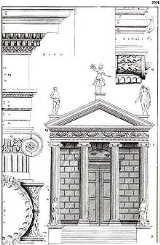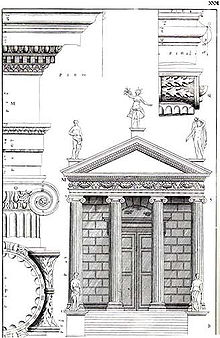
Isaac Ware
Encyclopedia
Isaac Ware was an English architect and translator of Italian Renaissance architect Andrea Palladio
.
He was apprenticed to Thomas Ripley
, 1 August 1721, and followed him in positions in the Office of Works
, but his mentor in design was Lord Burlington
.
Ware was a member of the St. Martin's Lane Academy
, which brought together many of the main figures in the English Rococo
movement, among them Louis François Roubiliac, who sculpted Ware's portrait bust about 1741.
Ware was dissatisfied with the first English translation (done by Giacomo Leoni
) of Andrea Palladio's I Quattro Libri dell'Architettura
, and in particular Leoni's illustrations. In 1738 Ware published his translation illustrated with his own careful engravings. Ware's version of the Four Books of Architecture remained the best English translation into the twentieth century in the opinion of Howard Colvin
. "Having thoroughly assimilated Palladian theory", observed Colvin, "he looked beyond it, and in the 1740s himself helped to dissolve the dictatorship of taste that Burlington imposed in the 1720s."
"Having thoroughly assimilated Palladian theory", observed Colvin, "he looked beyond it, and in the 1740s himself helped to dissolve the dictatorship of taste that Burlington imposed in the 1720s."
Aside from his Chesterfield House, Westminster
, (1747-52; demolished 1937) with its Palladian exterior and rococo interior details, he engaged in speculative building in the West End
of London and built a small number of country houses
, most of which have been subsequently remodelled or demolished. Clifton Hill House
, Bristol, and Wrotham Park, Hertfordshire survive.
Andrea Palladio
Andrea Palladio was an architect active in the Republic of Venice. Palladio, influenced by Roman and Greek architecture, primarily by Vitruvius, is widely considered the most influential individual in the history of Western architecture...
.
He was apprenticed to Thomas Ripley
Thomas Ripley (architect)
-Career:He first kept a coffee house in Wood Street, off Cheapside, London and in 1705 was admitted to the Carpenter's Company. An ex-carpenter, he rose by degrees to become an architect and Surveyor in the royal Office of Works...
, 1 August 1721, and followed him in positions in the Office of Works
Office of Works
The Office of Works was established in the English Royal household in 1378 to oversee the building of the royal castles and residences. In 1832 it became the Works Department within the Office of Woods, Forests, Land Revenues, Works and Buildings...
, but his mentor in design was Lord Burlington
Richard Boyle, 3rd Earl of Burlington
Richard Boyle, 3rd Earl of Burlington and 4th Earl of Cork PC , born in Yorkshire, England, was the son of Charles Boyle, 2nd Earl of Burlington and 3rd Earl of Cork...
.
Ware was a member of the St. Martin's Lane Academy
St. Martin's Lane
St. Martin's Lane is a street on the edge of Covent Garden in Central London, which runs from the church of St. Martin-in-the-Fields, after which it is named, near Trafalgar Square northwards to Long Acre.A narrow street with relatively little traffic, St...
, which brought together many of the main figures in the English Rococo
Rococo
Rococo , also referred to as "Late Baroque", is an 18th-century style which developed as Baroque artists gave up their symmetry and became increasingly ornate, florid, and playful...
movement, among them Louis François Roubiliac, who sculpted Ware's portrait bust about 1741.
Ware was dissatisfied with the first English translation (done by Giacomo Leoni
Giacomo Leoni
Giacomo Leoni , also known as James Leoni, was an Italian architect, born in Venice. He was a devotee of the work of Florentine Renaissance architect Leon Battista Alberti, who had also been an inspiration for Andrea Palladio. Leoni thus served as a prominent exponent of Palladianism in English...
) of Andrea Palladio's I Quattro Libri dell'Architettura
I Quattro Libri dell'Architettura
I quattro libri dell'architettura is an Italian treatise on architecture by the architect Andrea Palladio . It was first published in four volumes in 1570 in Venice, illustrated with woodcuts after the author's own drawings. It has been reprinted and translated many times...
, and in particular Leoni's illustrations. In 1738 Ware published his translation illustrated with his own careful engravings. Ware's version of the Four Books of Architecture remained the best English translation into the twentieth century in the opinion of Howard Colvin
Howard Colvin
Sir Howard Montagu Colvin, CVO, CBE , was a British architectural historian who produced two of the most outstanding works of scholarship in his field.-Life and works:...
.

Aside from his Chesterfield House, Westminster
Chesterfield House, Westminster
Chesterfield House was a grand London townhouse built between 1747-52 by Philip Stanhope, 4th Earl of Chesterfield, statesman and man of letters. The exterior was in the Palladian style, the interior Baroque. It was demolished in 1937 and on its site now stands an eponymous block of flats...
, (1747-52; demolished 1937) with its Palladian exterior and rococo interior details, he engaged in speculative building in the West End
West End of London
The West End of London is an area of central London, containing many of the city's major tourist attractions, shops, businesses, government buildings, and entertainment . Use of the term began in the early 19th century to describe fashionable areas to the west of Charing Cross...
of London and built a small number of country houses
English country house
The English country house is a large house or mansion in the English countryside. Such houses were often owned by individuals who also owned a London house. This allowed to them to spend time in the country and in the city—hence, for these people, the term distinguished between town and country...
, most of which have been subsequently remodelled or demolished. Clifton Hill House
Clifton Hill House
Clifton Hill House is a grade I listed Palladian villa in the Clifton area of Bristol, England which is now used as a hall of residence by the University of Bristol. The warden is Dr...
, Bristol, and Wrotham Park, Hertfordshire survive.
Ware's publications
The following list is taken from Colvin; all were published at London.- Designs of Inigo Jones and others, 1731. Second edition, 1743.
- The Plans, Elevations, and Sections of Houghton in Norfolk, 1735.
- The Four Books iof Andrea Palladio's Architecture 1738. Dedicated to Burlington.
- Two engravings of Rokeby HallRokeby ParkRokeby Park is a country house in the Palladian style in Northern England. It is located close to the confluence of the River Tees and River Greta, close to Greta Bridge in what is now County Durham. It was historically located in the North Riding of Yorkshire...
, Yorkshire. - A Complete Body of Architecture, issued in parts 1756-57. Second edition, 1767, reissued in 1768.
- The Practice of Perspective, from the Original Italian of Lorenzo Sirigatti, with the figures engraved by Isaac Ware, Esq. A translation of Lorenzo Sirigatti, La Practica di Prospettiva (Venice, 1596).

